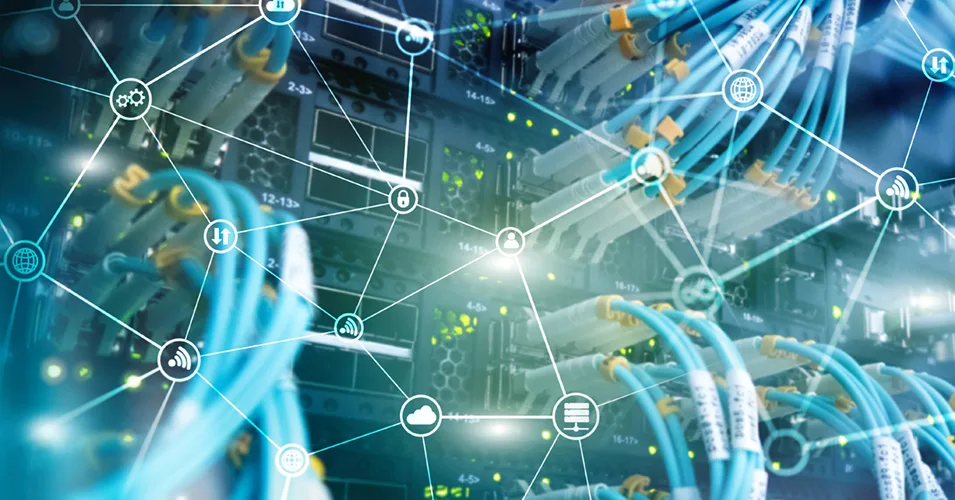October 12, 2021 | Dominic Romeo
3 Ways Data Center Interconnection Works for Your Business

Is data center interconnection the missing link in your data center strategy? Whether you’re looking to improve business continuity or help bring data processing closer to your users, you can stand to benefit from data center interconnection. Connecting your data with other centers across the country can help you achieve your digital transformation or business goals and better serve your customers. If you’re looking to adopt a hybrid cloud strategy, improve business continuity or disaster recovery, or if you want to move your IT infrastructure from your onsite data center to a third-party provider, you could benefit greatly from data center interconnection.
What is data center interconnection?
Data center interconnection is dedicated network connectivity that spans your data centers, permitting your apps, data, and users to connect reliably and quickly. With interconnection services, data center facilities offer services where customers can connect between various facilities across a regional or nationwide network. If you work with a provider that offers data center connectivity, resources can become available closer to your users via private lines, ethernet, and waves. This decreases latency and improves your users’ internet service experience. While the focus used to be on connecting first-tier markets, many centers can directly connect to second- and third-tier markets as well.
At any of these locations that are interconnected, you’re also likely to have support available for all assets under one roof, including a colocation data center, cloud services, and network assets. Plus, when you’re looking for processing and coverage in specific geographies, you can narrow in on providers that have data centers closest to your users.
How can data center interconnectivity benefit your business?
Edge computing enhances user experience
With edge computing, the close proximity of a data center to a user is what helps make for the best user experience (UX). You get high speeds and lower latency. While the service started in Tier 1 cities, those with the largest populations, Software-Defined Networking helped extend edge computing out to additional Tier 1 cities as well as Tier 2 cities and beyond.
Edge computing has been developing for decades. It started with content delivery networks (CDNs) in the 1990s and continued to take shape with peer-to-peer overlay networks (P2P) in the early 2000s, public clouds in the mid-2000s, and fog computing in the 2010s. These earlier technologies contributed to the eventual development of edge technology in different ways, including balancing workloads between machines and improving network distribution.
The U.S. edge computing market is expected to reach $3.2 billion by 2025. With edge computing, businesses are able to better cater to a remote workforce, process data from IoT devices, and reduce the load and actual weight of devices such as wearables and vehicles due to this closer data processing. The edge is where people and devices connect to the internet. It represents the location of all connected devices worldwide. When your business delivers computing to the edge, you’re better serving your customers exactly where they are.
Disaster Recovery / Business Continuity improves resilience
Before choosing a data center provider, you should be asking questions around reliability and resiliency. Downtime can be expensive, and relying on a provider that doesn’t have contingency plans for outages and downtime can be costly for your business.
Make sure you know about the type of network connectivity provided, how resilient the center is, how data and disaster recovery is handled, and types of cloud service or connectivity options available at the site, among other things. You can survive carrier outages unscathed if the center you’re working with is connected to other facilities, has buildings designed to withstand disaster, and has plans to offload data to another center should something unforeseen occur.
Hybrid solutions increase options for your workload deployments
Hybrid solutions include a combination of cloud and on-premises solutions, or multiple clouds off-premise. Expanding how your data is processed in this way can also keep you from feeling limited by cloud based applications or an on-premise center. With 58% of companies already using or planning to use hybrid infrastructure in the near future, thinking about what hybrid may look like for you is a step in the right direction, and data center interconnection can lend a hand.
Data Center Interconnection providers may also offer cloud onramps to public cloud providers. Cloud onramps are dedicated cloud connectivity for the major public cloud services. Think of it as data center interconnection for the public cloud providers.
Achieve resilience and high performance with a data center provider
As a data center provider, TierPoint offers all of the interconnectivity businesses need to effectively run their IT environment, no matter your needs. We offer a full suite of data centers across the U.S., so wherever your users are, we have them covered.
Are you wondering what building a data center on-premises vs. off-premises would cost? Check out our Data Center Build vs. Buy calculator.
